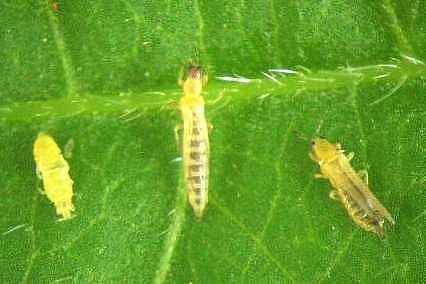(Megalurothrips spp. and Frankliniella schultzei)
Credits: Biovision-Infonet

(c) M. Billah, icipe
Thrips are small (1.5 mm long), slender, brown insects with pale yellow hind wings that appear as a yellow line down the back of the body when the insect is at rest.
Adult thrips have characteristic wings; the transparent wings have a fringe of hairs around the outside edge standing out in the same plane as the wing.
Several species of thrips are common on pigeon peas in Eastern Africa and are considered important pests.
These thrips feed on leaves and flowers. Main damage is due to thrips feeding on flower buds and flowers. Heavy infestation can lead to shedding of buds and flowers.
However, according to reports from India, pigeonpea plants produce more flowers than the plant can sustain, so many are lost naturally and it is difficult to assess thrips damage (Ikisan, 2000).
What to do:
- Conserve natural enemies. Predatory mites and pirate bugs are important for the natural control of thrips.
- Monitor the crop regularly. Early detection is particularly important at the onset of flowering.
- Whenever necessary spot spray the crop with botanicals. Some plant extracts (e.g. garlic, rotenone, neem, pyrethrum and a mixture of garlic and pepper etc.) are reported to control thrips. Spinosad, a bacterial derivative, is effective in controlling thrips.